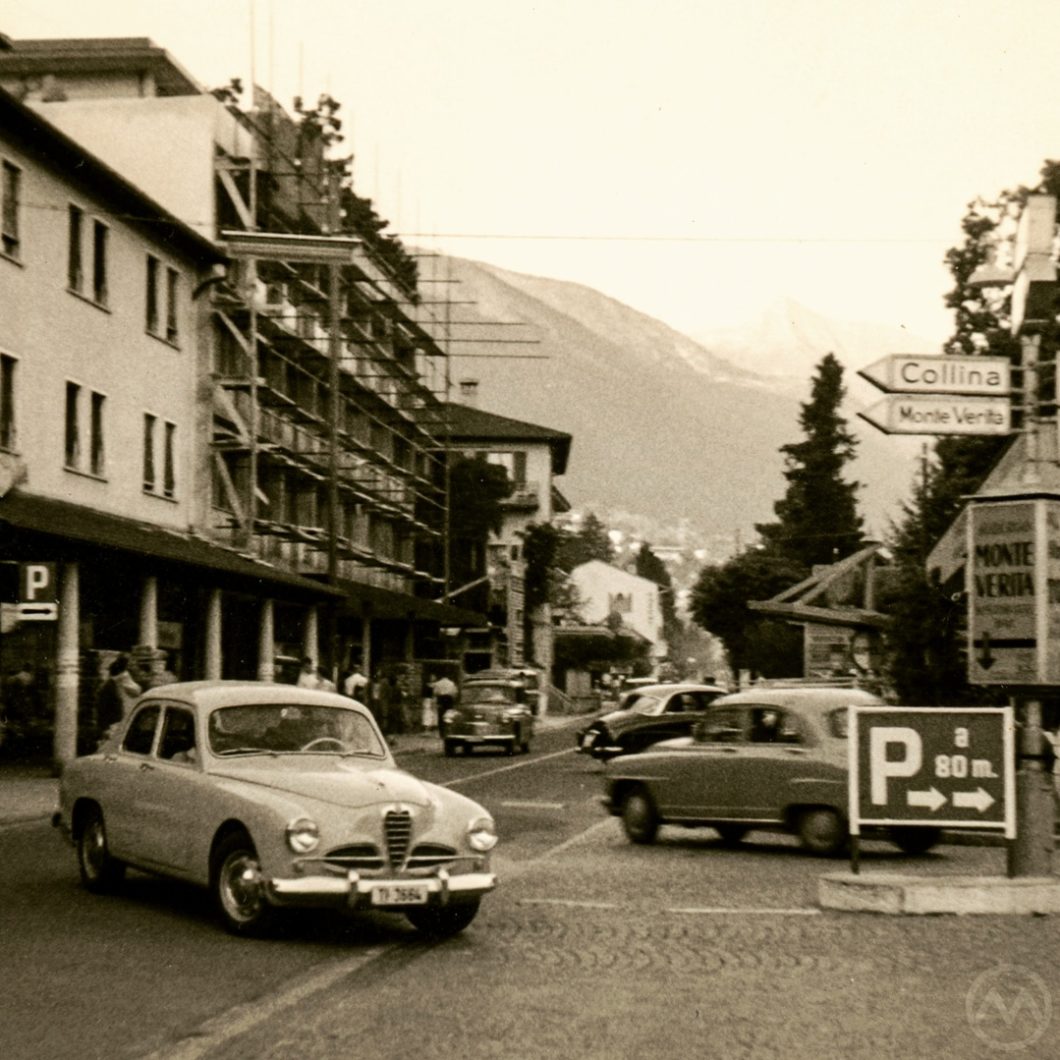Greetings from 1950s Switzerland! From Ascona, on the north end of Lake Maggiore, to be exact. A pair of Simca Arondes (a Berline and a Grand Large hardtop) face away from us and a Hillman Minx MkV approaches in the distance, but it’s the Alfa 1900 Berlina we’ll talk about today.
The Ticino plate indicates it was local to the area, living in Switzerland’s southern-most Canton just 80 miles from Milan. It’s not as exotic as many other Alfas or the derivative Alfa 1900 coupes, coachbuilt by the finest Italian carrozzeria, but the 1900 Berlina is the ancestor of all modern Alfas.
For all the great cars it made at the time, Alfa had only survived the depression due its value to Mussolini as a symbol of Italian industry and technology. It had been state owned since 1932, falling under the control of the Istituto per la Ricostruzione Industriale (IRI) a year later. Alfa’s most glorious racers and road cars, 6Cs and 8Cs, were all made possible by the backing of the state.
In late 1944, its main factory at Portello was levelled by allied bombs. By then Mussolini was dead and Italy in a civil war between the liberated Kingdom of Italy in the south and occupied territories in north. When the war was over, major political changes came including the end of the Monarchy and the founding of the Repubblica Italiana.
Rebuilding Alfa
For state owned enterprises it was a chaotic time indeed. Alfa’s Spanish director of engineering, Wilfredo Ricart, departed when his contract was up in 1945, leaving his subbordinate Orazio Satta as chief engineer. Though the company scraped together a series of 6C cars after the war, they were for the most part pre-war in origin. Ricart and Satta had been working on advanced new cars right up until Ricart’s departure, but there was no money to build them.
The future, and the Marshall Plan aid required to properly rebuild, would necessitate mass production. So it was that in the late 1940s chief engineer Satta engineered a four-cylinder, unit-body car that would be built on a proper production line – unlike the largely hand-made, small-batch earlier Alfas.
It was unlike any other Alfa before it, but Alfa’s then general manager Iginio Alessio dictated that it was almost two cars. The mass-produced unibody Berlina would be Alfa Romeo’s volume model and a revised version of the unibody would be created for coachbuilders. This would maintain some continuity from the Alfas of old.
At the heart of the car was a 90hp, 1,884-cc, alloy twin-cam. It may have been only a four, but it was ultra-modern for 1950 and heavily influenced by an earlier design for a new 6-cyl car, the envelope-body Gazelle. The Gazelle was one of several of those previously-mentioned projects Alfa had to abandon for lack of funds.
The 1900 Coupes would be much more famous, mostly because of their exotic bodywork. Pininfarina, Touring, Zagato, Bertone – all of them and more created versions. Franco Scaglione’s BAT 5, 7, and 9 concept cars were all Alfa 1900s.
The plainer but still handsome Berlina was styled in-house by Ferruccio Palamidessi and his draftsmen. Palamidessi would also design the later Giulietta Berlina, which unsurprisingly looked a little like a scaled-down 1900.
The Alfa 1900 Arrives
The car debuted at the 1950 Paris show. Nobody said “It’s not a ‘real’ Alfa.” Instead, they lined up to get one. For all the make’s reputation of fragility, the Alfa 1900 Berlina was generally a very robust car. However, early teething issues with stampings and assembly were resolved by a consultant from Finmeccanica – a new company set up by IRI to consult to the various industrials under its umbrella.
Hruska would play a huge role in Alfa later on – hired under Satta full time from 1954, he left for Fiat in 1959 but returned in the late 1960s to lead design on the AlfaSud and the Pomigliano d’Arco plant that built it.
Sold as “the family car that wins races,” it’s speed and durability won it plaudits and customers as well as the occasional race win.
The 1900 was a decent competition car, but also excelled in a variety of other roles. Speeders on the Autostrada might see them as pursuit specials, city dwellers as taxis. The Berlina was an expensive car for a cab, but they did exist. Sales were mostly confined to Italy, Switzerland, and France although the car could be ordered in many markets and was actually built in CKD form for a very short time at the former Imperia works in Belgium.
The car was quickly upgraded too – in 1951, the 1900TI got twin carbs and 100hp. In 1953 a 1,975-cc version of the engine debuted in the 1900 Super and 1900 TI Super, now with 115hp. Rev-happy and smooth, it came only with a 4 or 5-speeder. At around 2,200 lbs. on average, it was a quick car by the standard of family sedans of that time – but that’s what Alfa buyers expected.
The car was modestly restyled through the years, with more chrome and slightly softer features, and eventually, two-tone paint schemes influenced by American cars. Over 21,000 1900s were made, 80% of them Berlinas. This one, from the OldMotors archival collection, was probably built in 1953/54.
The black ink and manufacturing expertise provided by having built the 1900 directly informed Alfa Romeo’s next project – the truly volume-production 750-series Giulietta, which bowed in 1954.
The 1900 was replaced by the 2000 beginning in 1958, but the Berlina continued in production for another year. Descendants of the 1900 chassis were in production in Argentina into the 1980s.
Note: We’ll be labeling future posts of historic photos from the Old Motors collection “Flashbacks.” Look for more in the series.

